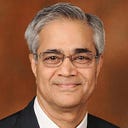Who is a Hindu?
Pradeep B. Deshpande
In 2009, Lisa Miller penned the column, “We are All Hindus Now” in Newsweek. The title begs the question, who is a Hindu and why anyone should be interested in the inquiry.
A laudable definition of the term Hindu is thus: हिनान गुणान दूषयति इति हिंदु: (Hinaan gunaan dushyati iti Hindu): One who considers the inferior Gunas as defective is a Hindu. This definition, or something close to it, is said to be of ancient origin. Hidden in this innocuous definition is the entire scientific framework for human transformation for a better and more peaceful world.
The Bhagvad Geeta provides the definition of the three Gunas (components) of the human mindset: The S component — Honesty, truthfulness, steadfastness, and equanimity. The R component — Attachment, ego, ambition, bravery, greed, and a desire to live, and the T component — Lying, cheating, causing injury in words or deed, and sleep. The definition of the three components is such that perfection (pure S) or for that matter, pure evil (all T) is precluded. Excessive R and T components are the inferior Gunas. And they are to be destroyed in favor of maximizing the S component.
The definition of the three components leads to a scale of internal excellence. The maximum S component is at the top of the scale while the maximum T component at the bottom and all the other combinations of the three in between these two extremes. The definition of the term Hindu suggests that one who engages in, and progresses in the struggle to rise in internal excellence is a Hindu.
Internal excellence has nothing to do with race, caste, religion, gender or national origin.
Now, internal excellence cannot be measured but emotions can. Positive emotions (unconditional love, kindness, empathy, compassion) strongly and positively correlate with the S component while negative emotions (anger, hatred, hostility, frustration, resentment, jealousy, fear, sorrow) strongly and positively correlate with excessive R and T components.
On the scale of emotional excellence, maximum positive emotions are at the top of the scale, maximum negative emotions are at the bottom, and all other combinations of the two somewhere in between these two extremes. Thus, the scales of internal excellence and emotional excellence are entirely equivalent.
The pursuit of positive emotions at the exclusion of negative emotions is a well-posed scientific problem since measurement devices for estimating emotions are available and the process with which to rise in emotional excellence is meditation, or more generally yoga, known for thousands of years.
The importance of emotional excellence has been understood since ancient times. There are numerous stories of Paratpara Shiva and Adyashakti in the Puranas wherein Adyashakti takes on various forms of Kali to destroy the demons of negative emotions.
In the eighteen chapters of the Bhagvad Geeta, Shri Krishna prods Arjuna, and through him, humanity to engage in the struggle to rise in positive emotions at the exclusion of negative emotions.
The importance of emotions for societal well-being is beginning to be recognized in America.
Peter Salovey, President of Yale and John Mayer, Professor of Psychology at the University of New Hampshire, coined the term Emotional Intelligence in 1990 and Daniel Goldman popularized it with his New York Times best-seller, Emotional Intelligence in 1995. According to HBR, Goleman’s paper on the topic is one of the most archived in their publication. UNESCO reportedly sent out a communication to 140 Ministries of Education urging them to introduce SEL (social & emotional learning) as a curricular requirement in schools.
Emotional intelligence is an intellectual inquiry to fundamentally understand the importance of emotions within oneself and in others while emotional excellence is the wherewithal of bringing about the required positive changes from within with meditation, or more generally yoga. An intellectual inquiry to acquire a higher level of emotional excellence is essential and important, but it is insufficient. For progress, the required positive changes have to come about from within.
Successful pursuit of emotional excellence brings about numerous benefits: Health & wellness, improved performance, leadership improvement, creativity and innovativeness, discoveries, interpersonal relationships, and less discord and violence. I have published many papers that provide details.
Emerging as a Hindu, if correctly interpreted, is an endeavor worthy of pursuing for everyone across genders, races, religions and nationalities.
Acknowledgments. The author is grateful to Dr. Mukul Gadgil, Dattatray V. Retharekar, and Dr. S. N. Bhavasar for their help with the definition of the term Hindu.
About the Author
Pradeep Deshpande is Professor Emeritus of Chemical Engineering at the University of Louisville and President of Louisville, KY-based Six Sigma and Advanced Controls, Inc. Pradeep has developed a scientific framework for external and internal excellence toward a better and more peaceful world. He has published several papers on the various aspects of the framework in India and the United States and has made presentations in several countries including the office of the Prime Minister of India and the Parliament of Peru always to enthusiastic audiences.
